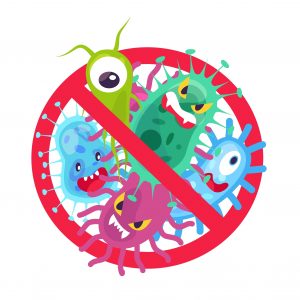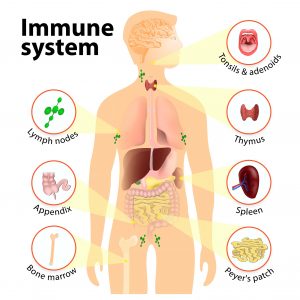Published on July 27, 2020
 Being exposed to viruses, bacteria, and toxins is a part of a normal day. They are in the air we breathe, the food we eat, in the water we drink and on surfaces we touch. Your immune system has been training since you were born to protect you from the “pathogens” that cause infection or disease. But sometimes, infection takes hold and your immune system has to fight off those pathogens. What you may not realize is that the nutrients in your diet directly influence the ability of your immune system to function. (We will discuss the roles of specific nutrients in immune function in more detail in future posts.)
Being exposed to viruses, bacteria, and toxins is a part of a normal day. They are in the air we breathe, the food we eat, in the water we drink and on surfaces we touch. Your immune system has been training since you were born to protect you from the “pathogens” that cause infection or disease. But sometimes, infection takes hold and your immune system has to fight off those pathogens. What you may not realize is that the nutrients in your diet directly influence the ability of your immune system to function. (We will discuss the roles of specific nutrients in immune function in more detail in future posts.)
Previous posts have specifically covered vitamin D in relation to immune cells and their function. Today’s post is a more general overview of what your immune system is and how it works to protect you.
What Exactly is Your Immune System?
The immune system is not one organ like your liver or kidney, but is composed of a group of organs, tissues and cells that work together to defend the body from invaders. There are several levels of this complex system that interact to protect you.
The first line of defense, the “innate” system, forms a protective barrier around the body and includes immediate non-specific defense mechanisms – think of it like a security system for your home.
The second line of defense, the “adaptive” system, is more specific and produces a response, such as making antibodies against a specific virus, that targets the invaders that make it past that first line of.
Immune cells are constantly roaming around the body surveilling for pathogens and checking in on other cells to make sure that they are not infected. Lymph nodes are specialized areas where immune cells hang out because they are areas where pathogens tend to be found.
What is the First Line of Defense?
 The innate immune system provides the first line of defense and is made up of many parts:
The innate immune system provides the first line of defense and is made up of many parts:
- Physical barriers: the skin provides a barrier that prevents entry, and mucus membranes produce mucus that prevent pathogens from being able to attach to surfaces and gain access through the gut or gastrointestinal tract
- Chemical barriers: acidity of the stomach kills some pathogens
- Biological barriers: we have a whole bunch of bugs that live on our skin and in our gastrointestinal tract (called our “microbiome”) that compete for space and prevent pathogens from being able to take up residence and cause problems
- Non-specific immune cells: “Phagocytes” like neutrophils and monocytes that engulf (or eat) and kill some pathogens; natural killer cells release toxic chemicals that kill some pathogens; and mast cells cause inflammation that attracts help from other immune cells
- Inflammatory signals: chemical signals are released by immune cells (eicosanoids and cytokines) to talk to other cells
- Complement proteins: can attach to and destroy some pathogens
The Second Line of Defense Specifically Targets the Pathogen
 The adaptive immune system consists of very specialized cells that target pathogens that evade the first line of defense.
The adaptive immune system consists of very specialized cells that target pathogens that evade the first line of defense.
The adaptive immune system is made up of:
- B lymphocytes (B cells): produce proteins (called “antibodies”) that bind to specific proteins on the pathogen
- Antibodies: special proteins (immunoglobulins, e.g. IgE) that bind to the surface of the pathogen and mark it (like a flag) for destruction
- Antigen presenting cells (APCs): immune cells (like macrophages) that digest and present bits of pathogen proteins to T cells
- T lymphocytes (T cells): T helper cells and cytotoxic T cells sample protein pieces presented by APCs to determine if they are from a pathogen; when pathogen proteins are detected by T cells they release chemical signals (cytokines) to launch a full attack on the pathogen and target it for destruction
- Complement proteins: attach to antibodies marking a pathogen and destroy it (complement proteins work in both the innate and adaptive immune systems)
Immune “Memory”
As you can imagine, because the adaptive system has to process, sample and then launch the destruction sequence, it takes a lot longer to take effect than the immediate and non-specific responses of the innate immune system. A third subtype of T cells acts to speed up the specific immune response when a pathogen is encountered a second, third or ‘n’th time. Memory T cells are a special subtype that serve to “remember” the specific pathogen involved in this encounter, so that should this pathogen enter the body again, the T helper cells would be able to activate B cells much faster, thus leading to rapid antigen-specific antibody production and a larger number of antibodies are produced. The pathogen is cleared from the body much quicker when encountered again.
Memory against one virus or bacterial pathogen can also cross-react with other similar viruses. This is the reason why some people who have been exposed to a different coronavirus may have some protection against COVID-19 and may not get sick or as sick as others who get the virus.
How does it all work together to protect me?
In order to establish themselves in the body, pathogens must first gain entry into the body by penetrating the first line of defense, including natural barriers such as the skin, tears, mucus and stomach acid. After a pathogen has entered the body, it is vital for cells of the immune system to identify the pathogen as foreign and destroy it. Non-specific cells of the innate system can identify some pathogens and kill them, but others that make it by that first line of defense get targeted by the adaptive system. That is when T cells and B cells launch a full-scale attack directed at the specific pathogen to destroy it. If you have encountered the pathogen before or one very closely related and your adaptive immune system fought it off, the pathogen triggers your immune memory and your T and B cells respond quickly to fight it off again.
What do Nutrients have to do with Immune System Function?
With COVID-19 running rampant, the role of nutrients in immune function has received particular attention recently, and for good reason. Nutrients are cofactors for processes throughout the body. They play roles in the immune system by regulating immune cell function, working to produce the ammunition to destroy pathogens and producing armor to protect you when your immune cells have to fire that ammunition in the body. When your body doesn’t get enough of the necessary nutrients, the immune system is compromised and doesn’t work at its full potential. Some of the nutrients of particular concern include vitamin D, vitamin C, zinc, magnesium, selenium and omega-3 fatty acids, among many others. GrassrootsHealth will be exploring the roles of each of these nutrients in upcoming posts.
What can you do with this information?
Learn more about how specific nutrients play direct roles in the various processes of the immune system response to infection. Do you know your nutrient levels? Do you know your levels of inflammation? Find out with the different home blood spot tests offered by GrassrootsHealth, including the Inflammation Panel and Magnesium*PLUS panel. Measuring levels is the only way to know if you are supporting your immune system and whether additional changes should be made, with supplementation, dietary changes, or both. Check your nutrient levels today!
Are You Getting Enough Vitamin D to Help Yourself?
We’re in a time of great crisis that could be greatly affected by making sure you and everyone you know has a serum level of at least 40 ng/ml. Help us help you.
Do you know what your vitamin D level is? Be sure to test today to find out, and take steps to keep it within a target of 40-60 ng/ml or 100-150 nmol/L! Give your immune system the nutrients it needs to support a healthy you and protect yourself from unnecessary diseases.
GrassrootsHealth Nutrient Research Institute is preparing to do a Community RCT with the use of our myData-myAnswers nutrient health system that over 15,000 people are already using for their health. We will demonstrate how one can use the Nutrient Research Model established by Dr. Robert Heaney to establish the effect of vitamin D serum levels of at least 40 ng/ml (100 nmol/L) on risk reduction with different ethnicities in the population. Please let us know if you’re interested in helping sponsor this project.
CLICK HERE for updates and new information about the project.
Through GrassrootsHealth Nutrient Research Institute, you can also test your essential elements magnesium, copper, zinc and selenium, toxins such as lead, mercury and cadmium, as well as your omega-3 levels, inflammation levels and thyroid stimulating hormone (TSH) level. Find out your levels today! Log on to the test selection page (click the link below) to get your tests and see for yourself if your levels can be improved.
Make sure you track your results before and after, about every 6 months!
Click Here to Access the Test Page
How can I track my nutrient intake and levels over time?
To help you track your supplement use and nutrient levels, GrassrootsHealth has created the Personal Health Nutrient Decision System called
For each specific supplement, you can track what days you take it, how much, and many other details. This will help you know your true supplemental intake and what patterns of use work for you to reach and maintain optimum nutrient levels. Check it out today!








